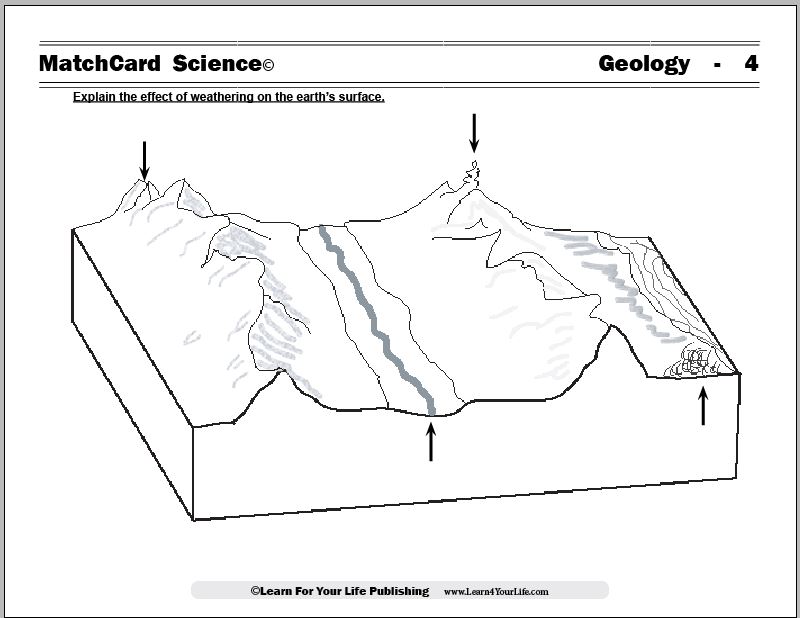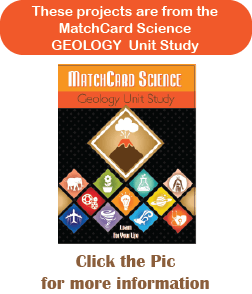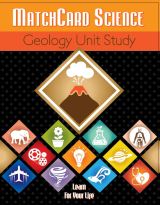Weathering Worksheet
Wind Erosion, Rain Erosion, Ice Wedging, and Chemical Weathering
This weathering worksheet is part of the MatchCard Science Geology Unit Study for 3rd to 8th grade. The MatchCards provide a worksheet, hands-on activities, and game-like review for earth science and geology.
Free Download Below


Weathering MatchCard
Objective: Explain the effect of weathering on the earth's surface.Overview: Students will use the place the reusable Information Pieces on the diagram of the land. They will match the type of weathering and its cause to the diagram.
Download MatchCard Science's Weathering Worksheet
This is MatchCard #3 of the Geology Unit Study. Look below for more information on MatchCards and the MatchCard Science curriculum.Let's Teach Weathering
Rain Erosion
Weathering Activity #1
Rain erosion is caused by rain and moving water which washes away topsoil and enlarges river beds.
Students will match the definition and description of rain erosion with the arrow pointing the river bed.
A Bottled River Bed
Let's watch the effect of water erosion on a river bed in a bottle:- Add the following to an empty two liter plastic soda bottle with a sealable lid:
- one cup of gravel
- one cup of pebbles (very small rocks)
- one cup of sand
- one cup of loose soil or silt
- Add water until the bottle is two-thirds full.
- Shake to mix, then lay it on its side and watch the solid particles settle.
- Gently aggitate by tapping on the wide end of the bottle. This would imitate a gently moving stream.
- Tap more vigorously to imitate a fast moving stream.
- How would you imitate rapid moving water at flood level?
Premade bottles of water and solid particles are available at science stores which can demonstrate an even greater variety of substances on a river bed.
Explore Local Creeks or Rivers
Visit creek and river beds in your area.What can you notice about the shoreline?
Compare the water level before and after a rain storm.
Notice the curvature of the river. Note how it may widen when the edge of the river is soil, but protrude into the river when the edge is rock. What do you think causes the curvature of river beds?
Wind Erosion
Weathering Activity #2
Large stones can be sanded down by small pieces of rock fragments carried in the wind.
Students will match the title and description of wind erosion with the picture of the rock formation on top of the mountain.
Let's Watch It: Sugar Cubes
- Build a rock formation out of sugar cubes and glue.
- Place outside in an area where blowing wind will affect the model.
- Take a picture when it is first put out and every few days.
Watch rain and water erosion at work together.
- In an open area that is exposed to the wind and rain, make the following:
- A mound of dirt about two feet high.
- A mound of sand about two feet high
- A mound of small rocks about two feet high.
- A mound of dirt covered with sod about two feet high.
- In addition, you may want to make the following:
- Measure the height of each mound, as well as the diameter from the base of the mound.
- Make a chart of your measurements. Note the rain and wind speed on your chart each day as well.
- Repeat the measurements every two days for a month.
- Write your conclusions in your science notebook.
- Bushes
- Trees
- Fence
- Buildings
- Fill a small jar to the top with water. A baby food jar would work well.
- Screw the lid on completely.
- Put the sealed jar in a zipped plastic bag.
- Put the bag in a second sealed plastic bag for additional security.
- Put in the freezer (or outside if the weather is below freezing) for 24 hours.
- The glass will be broken from the effect of expanding water. Handle bags carefully.
- Leave the bags in the sink to melt. Puncture a tiny opening in both bags to drain the water. Then dispose the bags without touching the glass fragments.
- The wind drives the water.
- The water cracks the rocks.
- The rocks block the wind.
- Break off three pieces of steel wool and put into each bag.
- Add a few tablespoons of water to one bag and seal.
- Add a few tablespoons of vinegar to the other bag and seal.
- Seal the third bag with no liquid in it.
- Observe in 24 hours.
- New gravestones
- Those that are 10 to 20 years old
- Those that are 50 years
- Those that are 100 years.
Science Fair Experiment
Let's turn the project above into a geology science fair experiment by changing a factor and seeing how much impact it has.Try putting mounds of dirt (same type) so they are shielded by:
Picture This
Look on the internet for pictures of unusual rock formations. If there are any locally, you may want to visit them and take your own photos.Ice Wedging
Weathering Worksheet Activity #3
Ice wedging occurs when water seeps into the cracks of rocks. As the water freezes and expands, it splits the rocks. On the weather worksheet, the students will match the title and description of ice wedging with the top of the mountain range to the left.
Let's Experiment
This simple experiment demonstrates the power of water. It could result in a skin lacerations from open broken glass, so caution and adult supervison is necessary.Mountain Climbing Time
If you live near a mountain or large hill, take a field trip. Look for areas where rocks have been split. Look for new cracks that are forming. Look for evidence of wind, rain, and ice weathering.Wind, Water, Rock
Many younger kids like to play the game "Rock, Scissors, Paper, Shoot" with their hands.To describe the affects of weathering, you might like to play a modified version, "Rock, Wind, and Water."
Chemical Weathering
Weathering Worksheet Activity #4
The composition of rock is changed by chemicals. This is greater where rocks and water meet.
On the weathering worksheet, the student will match the title and description of chemical weathering with the shoreline where the color of the sand has changed.
Let's Experiment
You will need a small amount of steel wool and 3 sandwich size sealable plastic bags.Acid Rain
Look for internet pictures or local buildings with effects of acid rain.Cemetery Field Trip
Go to an old cemetery to observe the multiple effects of weathering on tombstones. Compare:MatchCard Science
How To Use MatchCards

Download the FREE MatchCard Science Instructor's Guide and see how MatchCards can make building their science knowledge base fun.
Geology Unit Study

12 Science Unit Studies

Chemistry is only one of twelve complete unit studies for kids in 3rd to 8th grade.
Comprehensive objectives, hands-on projects, suggested science fair experiments, and the fun game-like MatchCards keep them interested in learning science. See all twelve MatchCard Science Unit Studies.
About Our Site
Hands-On Learning














